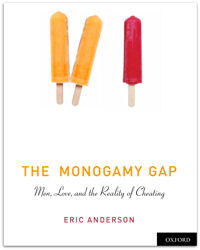
By Walter G. Meyer
April 23, 2012 (San Diego)--Comedian Ritch Shydner used to have a line in his act to the effect that, “Men and women will never get along because they are after two basically opposite goals: women are looking for the one man who can satisfy their every need and men are looking for every woman who can satisfy their one need.”
“The Monogamy Gap” by Eric Anderson and published by Oxford University Press, might be a little disturbing because it points out in a more scholarly way what Shydner observed. Anderson hails from Orange County and taught at UC Irvine before moving to England, where he is now a Professor of Sociology at Winchester University in Southampton.
Anderson says his writing of the book “was sparked from watching so many otherwise happy couples broken up over cheating. One couple had it all: history, careers, and a mortgage; but it all ended when one member had a one-off, drunken, sexual exchange with a stranger. They lost their relationship, their house, and because they worked together, their livelihoods. They ended up miserable and alone. I asked myself, did divorce serve this couple best? Did the punishment fit the crime? And would not they have been better off to just shrug off sexual infidelity as a product of biological desire and go about with their lives?”
He adds, “The book was formalized when I asked one of my classes of undergraduates how many had a relationship that lasted more than three months, and how many had ever been cheated on in such a relationship. Almost all raised their hands. It seemed monogamy to youth of this age is something everyone purveys, but few maintain.”
In the introduction to the book, Phillip L. Hammack and Bertram J. Cohler write that Anderson argues “that our preconceived knowledge notions of meaningful and committed relationships are steeped more in our blind acceptance of hegemonic institutions than an authentic assessment of how individuals negotiate love, sex, and relationships.”
Anderson created the term “dyadic dissonance theory.” By that he means that trying to maintain two opposing ideas: wanting a monogamous relationship, but also wanting sex with other people. He says that internal war puts undue stress on the individual and the couple.
“The evidence is abundant; monogamy fails as a social institution. Worse, the unreasonable expectation of monogamy sets families up to fail,” Anderson says. “I therefore argue that it is only when society accepts open marriages (what I call open sexual relationships) equal to that of monogamous relationships, will people be able to be honest about their sexual desires. Until then, monogamy is not a choice; it is instead thrust upon by our culture as a one-size-fits-all relationship expectation. At the end of the book, however, I do suggest that for a minority of men, monogamy seems to work just fine. It’s a small minority, and one can’t be sure their partner is suited toward that minority when there is cultural pressure to suggest you are within that minority, but it does exist. Ultimately, I suggest that I’m not looking for open relationships to be culturally expected, either. I desire all forms of adult relationships to be viewed with social equality.”
Most locals will remember that when Danielle Van Dam was murdered in 2002, the media and the defense attorneys almost tried the child’s parents as though their open marriage was somehow responsible for the rape of the second grader—as though any crime committed by any parent could somehow justify that. Their open marriage was bandied about in the news media as almost on a par with the rape of a child.
Anderson said, “That is the operation of stigma. Those who are deemed morally corrupt in one area are generalized to be corrupt in all. Of course, in the case of monogamy, my research shows that it is monogamy which is corrupt. Among the young men I interview, they reserved less judgment for those who cheated, than those who pursued open sexual relationships. As one young man said, ‘At least with cheating there is an attempt at monogamy.’”
This stigma is so great, that some people still have not forgiven Hillary Clinton for forgiving Bill. Anderson said, “The social expectation for Hillary to dump Bill is proof of the utility of monogamy to break families up, rather than hold them together. People wanted her family unit to dissolve, based off sexual infidelity, not emotional. But it is the emotional aspects of the marriage that count, not the sexual. We are policing the wrong component of a relationship.”
Anderson asks, which is worse: trying to live up to an impossible ideal or to be honest with your mate and try to achieve a relationship that can withstand the likely affair? By allowing for such things, there is no animosity when it happens and the relationship stays strong.
The book makes for interesting reading and conversation, but will likely make a lot of readers uncomfortable. As Anderson points out, to even bring up the subject of an open relationship is so threatening to many people that just the topic could lead to accusations of infidelity that could rip a marriage apart. So reader beware.
Walter G. Meyer is the author of the critically-acclaimed novel “Rounding Third,” and wrote the screenplay based on Anderson’s book “Trailblazing.”














Recent comments